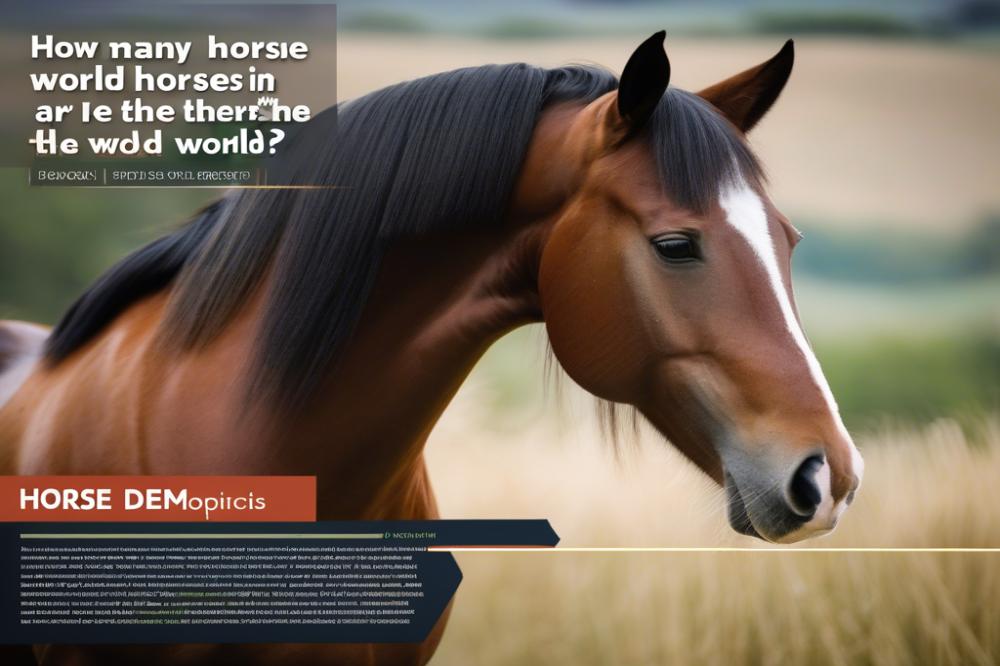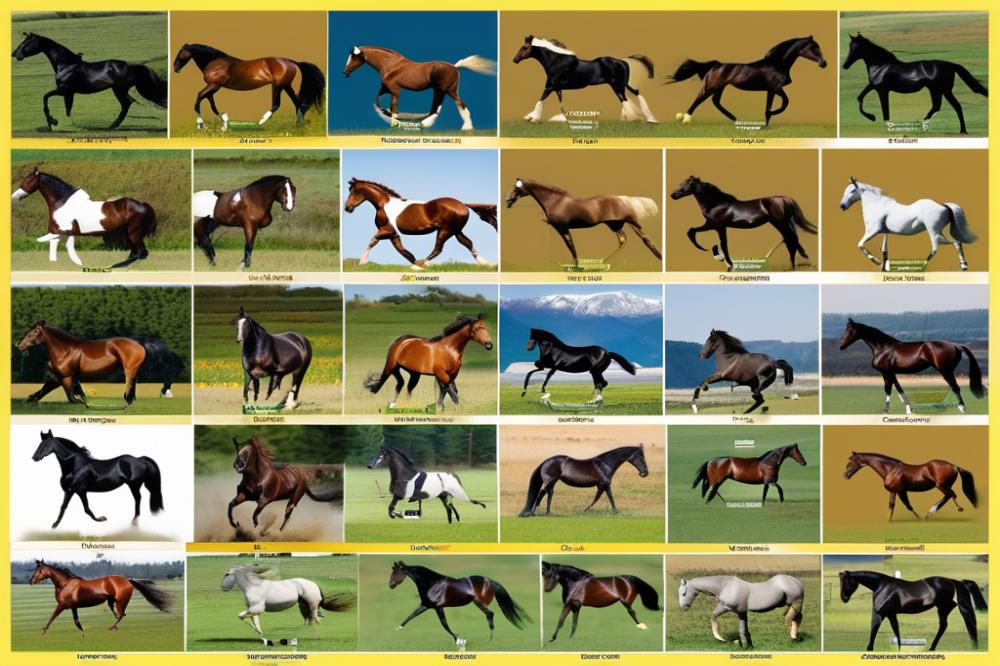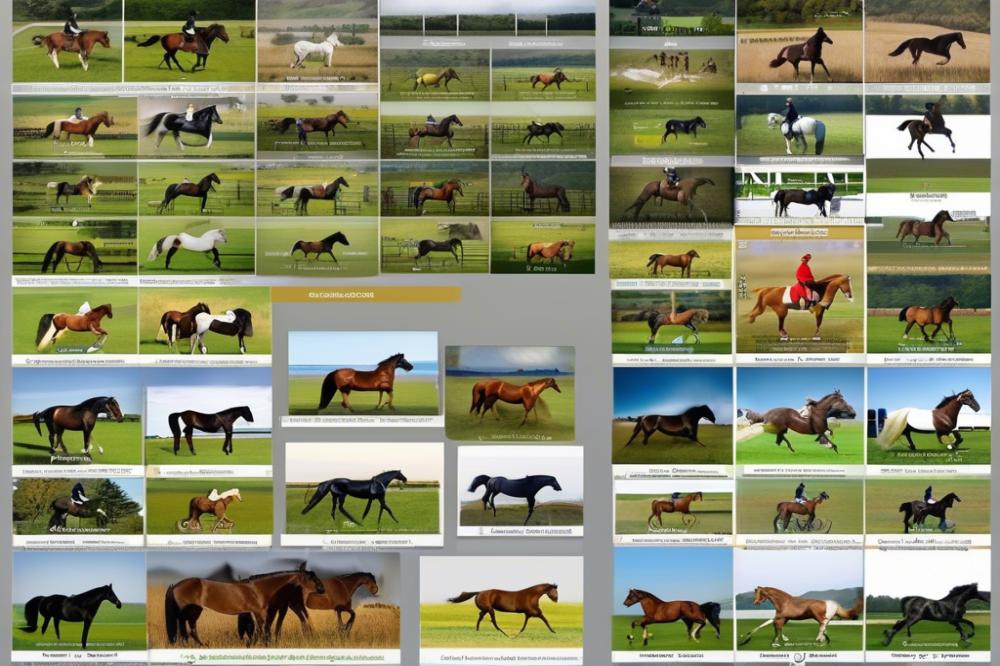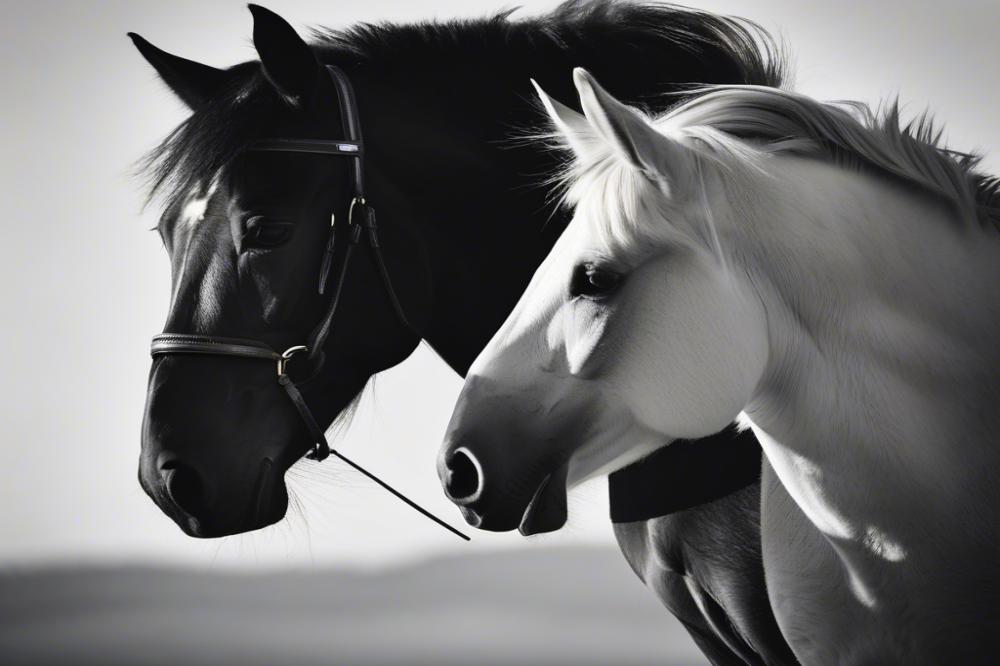Understanding Our Equine Companions
Horses have been part of human life for thousands of years. They carry stories and adventures, embodying a spirit of freedom that many of us admire. Think about it—these magnificent creatures have served as trusty companions, work partners, and even symbols of power throughout history. From gallant knights charging into battle to farmers plowing fields, a horse has played many roles. Their bond with humans goes beyond mere utility; it’s about connection, trust, and sometimes, just a whole lot of fun.
When we dive into the world of horses, horse demographics and various breeds quickly come to mind. There are thousands of horse breeds with traits that can make them suitable for racing, work, or simply being a lovable pet. Each breed carries its own charm and character. Wouldn’t it be fascinating to discover which breed is popular in your area or which ones were favored by your ancestors? Knowledge about horse populations can help us appreciate these amazing animals even more.
It’s also crucial to consider the equine industry, which feeds on the diversity and well-being of horse populations. From breeding practices to competition events, understanding the statistics of horses around the world can help guide everything from sales to care. How many horses exist stirs not just curiosity, but also establishes awareness about horse care and welfare. We must think about their happiness and health. After all, these creatures aren’t just numbers; they have feelings, just like us!
Not all horses are created equal, though. Some folks might be curious about elusive albino horses. Their stunning appearance can certainly draw attention! These unique animals are just one part of the rich tapestry of equine life. And let’s not forget the humorous questions people ask, like “can a horse drink beer?” It certainly makes for a good laugh, and understanding horse behavior can be as amusing as it is enlightening.
With a history as deep and varied as a twilight sunset, horses hold a special place in our hearts. Understanding how many horses there are in the world not only quenches our curiosity but also connects us to their intriguing past and future. So buckle up as we explore this vast and fascinating subject!
Historical Context

When you think about horses, their story spans thousands of years. Horse domestication began around 4000 BCE. Early humans started to recognize their strength and speed. These magnificent creatures were wild back then, roaming free on the steppes of Central Asia. Over time, humans learned to train them. It took some trial and error, but the bond between horses and people blossomed.
Horses helped change the world. They transported goods, carried warriors into battle, and pulled plows in fields. In fact, they became essential in many cultures. Different regions began to develop unique horse breeds based on local needs. For example, the Arabian horse is known for endurance, while the Clydesdale is famous for its pulling power. Each breed tells a different story about horse history.
Evolution of Horse Breeds
As humans mixed and matched horses, the concept of horse breeds really took off. Now, numerous types exist, fit for various purposes. Horses ended up on farms, in rodeos, and even in the circus. Breeding practices changed too, as people started focusing more on traits like speed or strength. The equine industry exploded thanks to this new variety, leading to equine statistics that astound even horse lovers!
Let’s not forget about horse demographics. Some breeds are incredibly popular, while others are quite rare. Depending on the country, you might find specific breeds nearly everywhere. For instance, the Thoroughbred is a star in the racing world, while the Appaloosa captures hearts with its spotted coat. Over generations, these breeds have evolved, reflecting everything from climate to culture.
Impact of Historical Events on Horse Populations
Throughout history, major events shaped horse populations. Wars led to significant losses and changes in breeding practices. Soldiers relied heavily on horses, resulting in high demand. Then, after the battles, many of these horses were left behind or unfortunately lost. Economic shifts also influenced the equine industry. The introduction of machinery replaced many horses in agriculture, leading to less demand.
In more recent times, horse care has been taken to a new level. People started to treat their horses as companions, not just tools. This shift led to a rise in interest and changes in horse ownership. Today, a balanced mix of leisure riders, serious competitors, and devoted owners makes up horse demographics globally.
Current Estimates of Global Horse Population

When we look at the numbers, it can be surprising to discover just how many horses roam the earth today. Experts estimate that there are around 60 million horses worldwide. This large number reflects a variety of horse breeds and their uses across different cultures. Understanding equine statistics helps us appreciate the role these creatures play in human history and society.
Countries with the Highest Horse Populations
Some countries clearly lead the pack when it comes to horse demographics. The United States takes the top spot, boasting about 9 million horses. China follows closely, with a similar count. Other countries, such as Brazil and Mexico, also hold significant horse populations. This diversity shows how horses are not just pets but also vital to industries like agriculture and sports.
Factors Influencing Population Numbers
Several factors influence how many horses there are in the world. Economic conditions play a big role. In places where people can spend money, the equine industry tends to thrive. Horse care is another important aspect. If people prioritize their horses’ health and well-being, they are more likely to keep them for longer periods.
Cultural values also matter. In some nations, horses are a symbol of tradition and heritage. They participate in festivals, ceremonies, and even sports! Conversely, in other areas, horses might face challenges because of urban development and changing lifestyles. When land becomes scarce, the number of horses can drop significantly.
Horse Breeds and Their Populations

Introduction to Various Horse Breeds
When we talk about horses, we’re really diving into a world filled with many different breeds. Horses come in all shapes and sizes. Some are small and sturdy, like the Welsh Pony, while others are tall and elegant, like the Thoroughbred. Each breed has its own history and charm, shaped by where they developed and how people used them. Have you ever seen a Clydesdale? Their majestic size can make anyone stop and stare. On the other hand, Arabians are known for their endurance and have a gentler appearance. Horse demographics show that there are over 300 recognized breeds around the globe.
Popularity and Distribution of Different Breeds Globally
Let’s chat about which breeds are the most popular. In North America, the American Quarter Horse reigns supreme. Known for their speed and agility, these horses are great for rodeos and ranch work. Moving across the pond, the Warmblood breeds are stars in Europe, especially in dressage and jumping competitions. Even in Asia, different breeds shine, like the Mongolian horse, known for its tough spirit and resilience. Some areas prefer certain types due to their historic roles. For example, mustangs symbolize wild beauty in the American West.
Conservation Status of Endangered Breeds
Not all breeds are thriving, though. Sadly, some are at risk of disappearing. Breeds like the Suffolk Punch and the Eriskay Pony are losing their foothold in the equine industry. Conservation efforts are crucial for these endangered breeds. Every horse deserves a chance to run on the pasture, right? Organizations globally are stepping up to monitor equine statistics and promote horse care. Preservation activities involve breeding programs and raising awareness. After all, the history of horses is rich, and we wouldn’t want to lose any chapter of it.
Diving deeper into the equine world reveals so much more. Each breed has its story, connecting us to a shared history. So next time you see a horse, take a moment to appreciate the journey it represents.
Factors Affecting Horse Population
Influence of Agriculture and Economic Development
Agriculture has played a substantial role in shaping horse demographics over centuries. Horses were once vital for farming. They pulled plows, carried loads, and helped farmers during harvests. Today, however, many machines do the heavy lifting. As technology advances, fewer horses are needed on farms. Countries that are more industrialized see a decline in their equine population. Yet, in rural areas, where agriculture still thrives, you’ll find a better balance of horse breeds. Economic health impacts this too. During tough times, people may find it hard to care for their horses. Statistics show that the equine industry fluctuates along with economic growth.
Role of Sport and Leisure Riding
Horseback riding brings joy to many. It’s not just a sport; it’s a way of life for countless people. Events like rodeos, racing, and dressage attract plenty of attention and funding. Many families invest in horse care for leisure purposes. Riding schools pop up, creating demands for more horses. These horses bring smiles and create lasting memories on trails, arenas, and fields. However, this passion can affect the global horse population. High demand for certain breeds may lead to overbreeding in some areas, straining resources. At times, it feels like horses are having a moment in the spotlight.
Impact of Urbanization and Land Use Changes
Urbanization has a noticeable impact on horse numbers. As cities expand, open spaces shrink. Where once there were pastures, now stand buildings and highways. Horses need room to roam and graze. This loss of habitat forces some owners to reconsider their equine companions. In bustling urban centers, people often turn to other recreational activities. In contrast, suburban areas still cherish horseback riding, though available land may be limited. The balance shifts as land use policies evolve. Local governments sometimes prioritize parks and green spaces, which can offer hope for horse lovers. In the end, the land tells a story about the future of equines amidst the concrete jungles.
Cultural Significance of Horses
Horses in Various Cultures Around the World
Horses have held a special place in the hearts of many cultures throughout history. From the wild steppes of Mongolia to the dusty plains of the American West, these magnificent animals show up in folklore, stories, and traditions. For instance, the Mongolian people have relied on horses for transport and herding for centuries. They are called “the friends of Man” and are central to their way of life.
In ancient Greece, horses were a symbol of wealth. The famous Trojan Horse, while a sneaky trick, highlighted their important role in Greek mythology. Meanwhile, in Indian culture, the horse is celebrated in various rituals and festivals. Stories of divine steeds appear in Hindu epics, demonstrating their deep-rooted significance.
By now, one might think about how many different breeds there are. You’ve got the majestic Arabian, the sturdy Clydesdale, and countless others. This diversity speaks to how horses have adapted to different environments and cultures, making their demographics as varied as the people who ride and care for them.
Symbolism and Roles in Traditional Practices
In many traditional practices, horses represent power, freedom, and grace. In Native American culture, horses are often seen as sacred. They are used in rituals to connect with spirits and to celebrate life’s important events. Picture this: a beautiful horse, adorned with colorful beads and feathers, strutting its stuff during a tribal ceremony. That image alone tells you how much they mean.
Across the world, horses have also been symbols of nobility. Kings and queens rode majestic steeds into battle, side by side with their troops. Such scenes evoke thoughts of bravery and valor. In everyday life, however, their roles have expanded. In agriculture, people depend on horses for labor. This versatility ties them to both history and the equine industry even today.
Horses in Sports and Entertainment
When it comes to sports, horses are undeniably star players. From the thrilling jumps of show jumping to the elegance of dressage, equine statistics show how talented these animals can be. Not to mention, horse racing is a sport that gets the adrenaline pumping. Many people flock to tracks worldwide to cheer for their favorites. The excitement in the air during a race is palpable.
Entertainment also has a soft spot for these magnificent creatures. Who hasn’t been captivated by a horse galloping across the screen during a movie? Westerns and epic dramas often feature horses as key characters. They aren’t just animals—they are partners in crime or heroes in their own right.
In the realm of rodeo, competition reaches new heights. Events like barrel racing and bronc riding are part of the thrill. Spectators can’t help but hold their breath while watching the incredible partnership between rider and horse. The bond created through hours of horse care and training is evident in these moments.
Horses truly enrich many aspects of culture and society. Whether in myth, ceremony, or competition, they continue to play a vital role in our global tapestry.
Future Trends for Global Horse Population
Predictions for Population Growth or Decline
Some experts believe the number of horses might increase in the coming years. More people are showing interest in equestrian activities, which could drive demand for horse ownership. On the other hand, economic downturns can lead to a decline in the equine industry. When budgets tighten, horse care can be one of the first expenses cut. It’s a bit like a roller coaster, with thrilling highs and stomach-dropping lows. Horse demographics are fascinating to watch.
Impact of Climate Change on Horse Habitats
Climate change poses significant challenges to horses and their habitats. Regions that were once lush and green may turn dry and unwelcoming. Migrating to find better grazing areas can become a necessity for some breeds. Owners need to think about how to keep their horses healthy in extreme weather. Changing climates could alter breeding patterns and influence where horses live. Every hoofprint matters, so protecting natural environments is key.
Emerging Trends in Horse Breeding and Ownership
Breeding is evolving. New horse breeds are hitting the scene, offering exciting options for enthusiasts. People are also exploring sustainable practices, focusing on health and well-being. Meanwhile, technology is reshaping horse care. It’s now common to find apps that help track horse fitness and nutrition. Many owners are becoming more informed about their horses’ genetics and health history. Networking within the equine community has never been easier with social media.
Horse ownership is no longer just about riding. Folks are increasingly interested in the whole package, from breed selection to care routines. The importance of proper horse care has become clear, and this is encouraging responsible ownership. As we look ahead, it’s fascinating to think about how horses will fit into our changing world. Riding into the future, many possibilities await!
Wrapping It All Up
When we look at the big picture, understanding the number of horses on our planet offers more than just statistics; it reveals a world full of stories and connections. Current estimates suggest there are around 58 million horses globally. But just because a number exists doesn’t mean it tells the whole tale. Every horse brings its own personality to the mix, whether trotting in a competitive arena, grazing in a pasture, or even wading through the murky waters of a local swamp. That’s what makes the global horse population so fascinating.
Preserving different horse breeds is important, and let’s not forget their habitats too. Every breed has its own history, like the beautiful Arabians that reflect ancient lineage or the sturdy Mustangs that symbolize freedom in the wild. If we don’t make an effort to protect these breeds and their environments, we risk losing parts of our history and culture. Imagine talking about the majestic Clydesdales only to find they’re no longer around. That’s like reading a book with all the best chapters missing!
Moreover, let’s not ignore what’s happening in the world of riding. There’s a rich tapestry of styles like English versus Western riding, each offering unique experiences for riders and horses alike. Whether you prefer the graceful dressage routines or the spirited barrel racing, what binds us all is the bond we create with these incredible animals.
Finally, we can’t forget about sustainable horse practices. Each of us can make a difference by supporting local initiatives, being kind to our horses, and promoting ethical treatment. Have you ever wondered what horse meat tastes like? While that’s a topic for another day, it points out how discussions around horses extend beyond riding and breeding. They touch on ethical practices, food choices, and cultural differences. So, let’s rally together to ensure a future where horses thrive and continue to inspire us.
By getting involved, we can all play a part in safeguarding these magnificent creatures. Volunteer at a local rescue, support programs dedicated to horse welfare, or even just spread the word about the importance of caring for our equine friends. After all, it might just be the hoofbeats of a horse that bring a smile to your face and a reminder of the beauty in the world.



